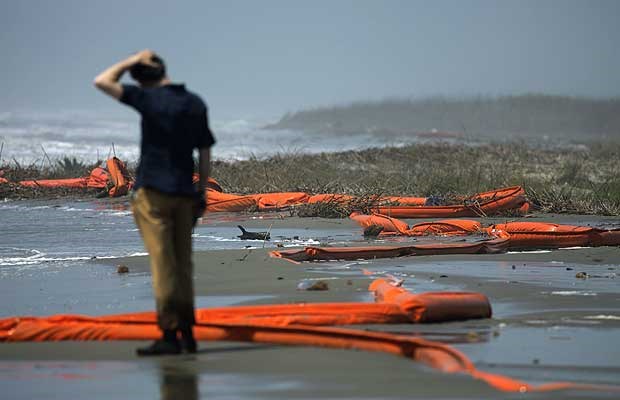The thing to remember about oil drilling is that it's safe. Of the thousands of oil and gas platforms in the Gulf of Mexico, only one, the Deepwater Horizon, blew up, creating an environmental disaster that might be felt for 30 years.
Ditto for tanker traffic from Alaska. Of all those ships going up and down the coast, only the Exxon Valdez took a wrong turn at Albuquerque and punched itself open on the rocks, altering the ecology forever.
Same deal right here off Victoria. Medium-sized tankers regularly unload Alaska crude at Puget Sound, Cherry Point and Anacortes, Wash. None of them has turned our coastline into a giant tar ball. So far.
That's the problem. It only takes one.
Oil tankers passed through Juan de Fuca Strait 1,056 times last year, according to Washington state's Department of Ecology. Tugs towed 101 loaded oil barges past our front door, too. The Canadian and U.S. coast guards recorded 8,849 commercial ship movements in and out of the strait in 2009. It's tough to believe that yesterday's gentle "We're not in Kansas anymore, Toto" Mayvember breeze didn't stick at least a couple of them on the beach.
Of course, there's an easy way to diminish this threat: Stop using fossil fuels. You go first.
Alas, the truth is that with the easy-to-get-at oil gone, we are turning to trickier, riskier extraction methods such as the deep-water drilling effort that went sideways in the Gulf of Mexico on April 20. Alberta's oilsands give David Suzuki nightmares. This spring, Barack Obama announced plans to lift the offshore oil-drilling moratorium in much of the U.S. -- though not, notably, along the Pacific coast of the continental U.S.
Canada has had its own moratorium on drilling in the Pacific since 1972, though one of the first things Gordon Campbell tried to do after taking power in 2001 was get an offshore oil-and-gas industry going. That effort fizzled, in part because of uncertainty over who has jurisdiction over the seabed, Ottawa or the province.
Canada also banned oil tankers from B.C.'s inner coast -- not that the federal government seems married to that notion anymore. After the Conservatives took power, Transport Canada blithely announced that no ban existed, that all we have is a voluntary exclusion zone keeping oil tankers out of Dixon Entrance, Hecate Strait and Queen Charlotte Sound as they travel between Alaska and the continental U.S. This interpretation, while perhaps technically correct, came as a surprise to many, including Victoria's former Liberal cabinet minister David Anderson, who understood what Pierre Trudeau was up to when shaping Ottawa's Pacific oil policy.
The idea was to keep tankers out of inside waters.
The Conservatives' weaselling seems tied to Enbridge's proposal to build a $4.2-billion, 1,200-kilometre pipeline from Alberta to Kitimat. The oil from the Northern Gateway pipeline would be hauled away by tanker, 225 of them a year, navigating the same enclosed waters in which the Queen of the North sank.
Environmental and aboriginal groups oppose the project. Many Americans are also nervous, since they think of the Alberta oil as being part of their strategic reserve, and the Enbridge pipeline would allow it to go to China, not the U.S. -- it's one thing to risk a spill for your own good, another when the beneficiary is Asia.
Jennifer Lash, executive director of the Living Oceans Society, doesn't want any risk to our waters at all, wants Ottawa to stop messing about and strengthen, not weaken, its moratorium through legislation.
"The accident in the Gulf of Mexico is proof that we can't afford to put our coast in the same position," she said yesterday from Sointula, a ferry ride from Port McNeill. Anderson doesn't think legislation is needed, says Ottawa merely needs to reaffirm its drilling and tanker bans; we can't ask Alaskan tankers to avoid our inside waters while allowing others to fill up at Kitimat.
The thing is, there will always be risk as long as we burn oil. In December 1988, a barge spilled 875,000 litres of bunker fuel off Grays Harbor, Wash. The spill was 250 kilometres from Vancouver Island and was just one-fiftieth the size of the Exxon Valdez disaster of 1989, yet still fouled beaches from Sooke to Nootka Sound. Thousands of dead and dying birds washed ashore, as did cow-patty sized globs of goop that took months to clean up.
A decade ago, someone figured out that it takes the U.S. just 22 minutes to consume the amount of fuel spilled by the Exxon Valdez. The oil tankers that pass through Juan de Fuca Strait can carry close to four times that much. Those ships aren't stopping. And it only takes one.



